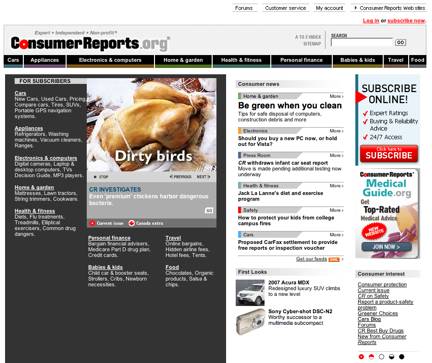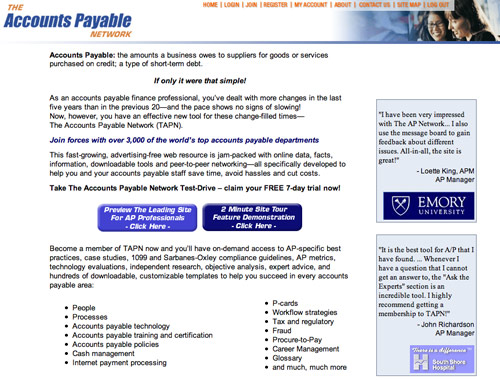A membership website is a user driven, content-based website satellite that generates the majority of its revenues from user access fees.
B2B publishers often convert loose-leaf information services and their monthly updates into membership websites for ease of updating and easy user access. B2C publishers often convert their back issues into a special-interest library categorized by topic.
Membership websites are used as reference tools by users who seek a trustworthy answer to a specific question—often as part of an immediate decision-making process. We’ve profiled two Mequoda best practice websites, the B2C site, Consumer Reports and the B2B site, The Accounts Payable Network in this chapter.

A membership website is a user driven, content-based website satellite that generates the majority of its revenues from user access fees. This website business model is similar to a book club, professional association or user group that accepts little or no advertising, relying primarily on user support.
The content in a membership website is also often sold on an ala carte basis as books, reports, newsletters, magazines or other simple information products. B2B publishers often convert loose-leaf information services and their monthly updates into membership websites for ease of updating and easy user access. B2C publishers often convert their back issues into a special-interest library categorized by topic.
[text_ad]
Membership websites are used as reference tools by users who seek a trustworthy answer to a specific question—often as part of an immediate decision-making process. We’ve profiled two Mequoda best practice websites, the B2C site, Consumer Reports and the B2B site, The Accounts Payable Network in this chapter.
Key Concepts
Business Goals: A best practice Membership Website has two business goals: acquire and retain members. As with the Internet Hub Archetype, an effective Membership Website presents two faces to the consumer based on the user’s registration status.
Unknown users are presented information and conversion architecture with the primary intent of converting the unknown user to a registered or known user. This may include sample content with clear messaging that full content is only available to registered users and an offer to join. Effective conversion architecture will also include one or more Sales Letter Landing Pages (SLLP) that are similar to a direct mail sales letter used by real world membership organizations, special-interest magazines and book clubs.
Registered or known users are presented with content designed to help them quickly find the information they seek. Users who find the information they want or need are more likely to use the website again and consequently renew their membership.
User Goals: Users see membership websites as a source of immediate answers and solutions. However, having the answers is only half the story for a successful membership website. If the information the user wants is difficult to find, (even if the information is available somewhere on the site) the user believes the publisher is not meeting their needs.
Revenue Model: Membership websites operate on a simple pay-for-access model. Users may often choose the time interval they wish to be charged (daily, weekly, monthly or annually). Annual pricing will be the lowest access fee-per-day with daily being the highest. Many B2B Membership Websites also offer non-members the opportunity to purchase a single report for a premium price.
The majority of Membership Websites rely on electronic billing via credit card on a continuous service basis—a concept pioneered and popularized by Internet access provider AOL and many daily newspapers.
Content: Membership website content ranges from a few lines of source code, to the user satisfaction rating for a new car, to a recipe for onion soup. The successful Membership Website offers answers and solutions that make the user’s life easier and their activities more successful.
Some Membership Websites, like WordTracker, are primarily software programs offered over the Internet on an ASP (application service provider) basis. Others, like Wine Spectator Online, are primarily a comprehensive reference library used to facilitate purchase decisions. And still others, like Fine Woodworking, are a combination of how-to skill builders and product reviews.
Navigation: Membership Websites use topic-based information architecture to empower users to browse the website content as they would a reference book. One or more tables of content, site indexes or site maps, and keyword search are all simple and effective tools that improve content findability. Usability testing has shown that a hierarchy of hyper-linked text is usually the best way for users to successfully find and follow the scent of information.
Consumer Reports
The World’s Most Popular Premium Membership Website Had No Choice
Membership Websites rely on the user of information to pay directly for the content provided via a membership access fee. In the print world, Consumer Reports, the well-known product review magazine, relies solely on its subscribers to pay for the magazines. They don’t ask for or accept any advertising revenue. In return, the subscriber receives unbiased reviews on a wide range of products. So, when Consumer Reports created a website, they knew the consumer would have to pay to support it.
“In 1999 when we were launching the website, we knew we could not take advertising, based on Consumer Union’s mission, vision and values,” says CU’s Executive Vice President Joel Gurin. “When everyone else was giving content away for free, we knew had to charge for ours. That was very focusing.”
Gurin says it was that focus that helped them to be successful. ConsumerReports.org now has 2.3 million paid subscribers, making it the largest paid subscription website in the world. In response, the organization has launched two additional subscription websites with a third on the way. The websites are also a major source of paid subscriptions for the companies’ print magazines and newsletters. To differentiate their electronic product from their print product they took advantage of the Web’s electronic capabilities and created software applications that allow their subscribers to search old issues for past reviews. ConsumerReports.org search function allows readers to find exactly what they’re looking for in mere seconds.
A Mequoda Membership Website is the easiest (of the seven) to keep audience-driven, because user spending drives the financial performance of the organization. In addition, the organization has no major suppliers who have to be part of the extended organizational structure.

Consumer Reports is the flagship example of a highly successful Mequoda Membership Website. With 2.3 million paid subscribers, it is the most popular membership website in the world. The revenue source for membership websites is very simple: they make money by charging for access to their content.
Yahoo! Site Explorer reports that the site includes 61,413 pages of content with 239,884 inbound links. With 2.6 million unique U.S. visitors in December 2006, the Consumer Reports website is ranked #553 by Compete—making it one of the top five magazine websites in America. (The site likely has more content behind the membership firewall that is not being counted by Site Explorer).
The Accounts Payable Network
A B2B Membership Website with Great Content and State of the Art Usability
The Accounts Payable Network describes itself as the most comprehensive, specialized resource available for accounts payable professionals by providing—in one convenient, online location—current solutions for AP strategy, technology, people and processes.
That’s a big promise, especially considering that the subscription website was launched less than five years ago by Financial Operations Networks LLC and its founder, Phil Binkow. But The Accounts Payable Network doesn’t disappoint; it overwhelms the AP professional with valuable tools and content

The Accounts Payable Network does an exemplary job of implementing effective design practices. They are a prime example of a successful Mequoda Membership Website.
The Accounts Payable Network landing page is clean and simple. It states its offer and unique selling proposition clearly, displays a couple of subscriber testimonials, and offers a free trial.
The choices on the landing page are “Free Trial” or “Go to Member Home Page.” Clear enough. Signing up for the trial is straightforward and requires the users to agree to the Terms of Service.
Trial membership confirmation arrives via email, which requires user activation. Within 30 minutes of registering, we received a personal phone call from an Accounts Payable Network Membership Executive, who offered us access to some of the members-only sections not normally available to trial members. This is very attentive customer service, of course, and not the completely automated service we were expecting from a well designed website.
The Accounts Payable Network has 2006 unique U.S. website visitors ranging from 2,100 to 11,700 with 1,201 pages of content and 303 inbound links as reported by Yahoo! Site Explorer. In all likelihood, the site likely has more content behind the membership firewall that is not being counted by Site Explorer.
This article was written by Don Nicholas with the help of Peter A. Schaible. It is only one part of a series on Internet Business Models. See below for the rest of this series:


